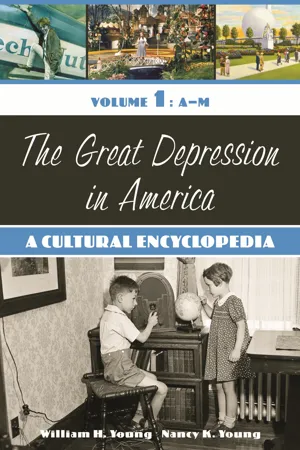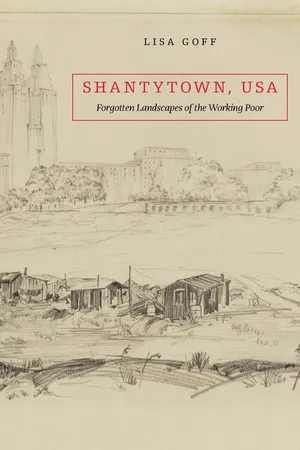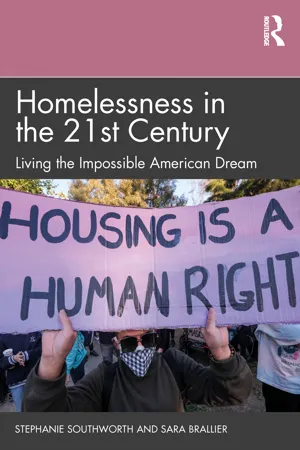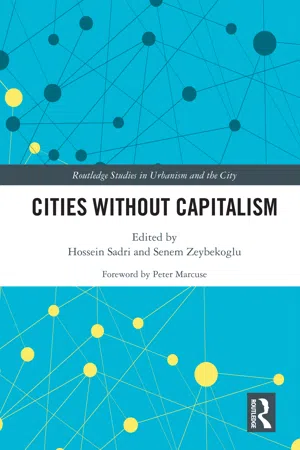History
Hoovervilles
Hoovervilles were makeshift communities of homeless people during the Great Depression in the 1930s. They were named after President Herbert Hoover and symbolized the widespread poverty and unemployment of the era. These shantytowns consisted of tents, shacks, and other improvised dwellings, and served as a visible reminder of the economic hardships faced by many Americans during that time.
Written by Perlego with AI-assistance
Related key terms
1 of 5
7 Key excerpts on "Hoovervilles"
- eBook - PDF
The Great Depression in America
A Cultural Encyclopedia [2 volumes]
- William H. Young, Nancy K. Young(Authors)
- 2007(Publication Date)
- Greenwood(Publisher)
Hoover saw drought relief emanating from state and local municipalities, but people clamored for the president to offer direct federal aid. Seemingly powerless in the face of calamitous events, Hoover soon found his surname the butt of many jokes. A Hooverville consisted of a collection of tents, cardboard boxes, tarpaper shacks, and the like that served as housing for the homeless. Usually located close to railroad tracks, Hoovervilles multiplied during the early 1930s. ‘‘Hoover blankets,’’ accumulated newspapers under which the jobless and homeless often slept, provided a different kind of shelter. Scarcity of food forced some to eat small game, all of which got called ‘‘Hoover hogs.’’ Rundown shoes, usually with visible holes in the HOOVER, HERBERT 240 soles, became ‘‘Hoover shoes,’’ and ‘‘Hoover leather’’ meant the cardboard inserted to resole them. ‘‘Hoover flags’’ referred to empty pockets; when destitute people turned their pockets inside out to indicate that they were broke, the exposed white linings somewhat resembled flags. ‘‘Hoovercart’’ and ‘‘Hooverwagon’’ rodeos began in 1933 and swept the country. The events involved hitching mules to the sawn-off back halves of decrepit Model T Fords and racing them through obstacles, the bumpy course a symbol of the equally bumpy economy. Not all Americans opposed Hoover and his programs, however, and those who had faith in the beleaguered president gained the name Hoovercrats. In 1931, Grant Wood (1891–1942), a popular Regionalist painter from Iowa, depicted Hoover’s early rural home in a canvas titled ‘‘The Birthplace of Herbert Hoover.’’ Hoover held the honor of being Iowa’s first citizen to reside in the White House and clearly stood as its most famous resident, although, given the times, not necessarily its favorite son. In the spring of 1931, Europe sank further into an ongoing economic crisis, an event that negatively affected the American banking system. - eBook - PDF
Shantytown, USA
Forgotten Landscapes of the Working Poor
- Lisa Goff(Author)
- 2016(Publication Date)
- Harvard University Press(Publisher)
The depression and droughts of the 1930s swelled the ranks of the homeless poor across the country. Many slogged from town to city or field to orchard looking for work and a place to live. Families, youths, and single women crowded into inner cities, renting rooms in lodging houses and tenements or, if penniless, bedding down in the shelters and missions run by cities or charitable organizations. Transient men, romanticized in the 1930s as hoboes, often lived in “jungles” at the edges of cities or near railroads or ports, or in flophouses on the edge of downtowns. Out West, families traveled from cheap auto camp to cheaper auto camp, in an exodus memorialized in John Steinbeck’s Grapes of Wrath, speeded on their way by donations of gas and oil from overwhelmed relief agencies whose solution to transients was to keep them moving past the city line. But an estimated 100,000 under- or unemployed people spent the 1930s not in hobo jungles, center-city lodging houses or auto camps, but in the dozens of American shantytowns known as Hoovervilles. 8 Although shanties in the twentieth century, like those in the nineteenth, were generally constructed mostly of wood, they sometimes reflected the availability of geographically specific natural resources. Migrants built log shanties along the Iron River in Michigan. A writer for the Federal Writers’ Project saw “palmetto-thatched huts with floors of rough boards or hard Troops under the command of General Douglas Macarthur set fire to the shantytown built by the Bonus Army on the Anacostia flats in Washington, DC, in 1932. 228 s h a n t y t o w n , u s a packed dirt” in the Florida Everglades in 1938. After the 1920s, car and truck parts appear regularly in shanties, sometimes forming the basis of the struc-ture. As the Farm Security Administration photographs of the 1930s and 1940s demonstrate, some shanty builders showed great creativity in the matter of siding, roofing, front doors, and general decoration. - eBook - ePub
Homelessness in the 21st Century
Living the Impossible American Dream
- Stephanie Southworth, Sara Brallier(Authors)
- 2023(Publication Date)
- Routledge(Publisher)
Legends of America. www.legendsofamerica.com/20th-Hoovervilles/ .- Heathcott, J. (2012). The strange career of public housing: Policy, planning, and the American metropolis in the twentieth century. Journal of the American Planning Association, 78(4), 360–375. https://doi.org/10.1080/01944363.2012.740296 .
- Ibid.
- Rossi, P. H. (1990). The old homeless and the new homelessness in historical perspective. The American Psychologist, 45(8), 954–959. https://doi.org/10.1037//0003-066x.45.8.954 .
- The high-rise public housing projects concentrated poverty in areas without resources, often in areas of cities that were near jobs. This concentration, along with the new suburbs, created an unprecedented level of racial and economic segregation in American cities.
- These benefits mostly went to White veterans. The impact of these benefits will be discussed in more detail in Chapter 2 .
- Rossi, P. H. (1990). The old homeless and the new homelessness in historical perspective. The American Psychologist, 45(8), 954–959.
Passage contains an image
Chapter 2 Neoliberal Ideology and Homelessness
DOI: 10.4324/9781003325581-3“I go here, I go there. No one understands that I can pay for housing. I just can’t pay that much. I need to be able to put gas in my car and eat.” Jared, a 40-year-old White maleIntroduction
Social problems, such as homelessness, do not occur in isolation and can be mitigated with good policy decisions. The magnitude of homelessness we see today was not inevitable. As we discussed in Chapter 1 , in the late 1970s, homelessness had almost disappeared from the social landscape in the United States. In his 1976 book about the history of housing, Anthony Jackson wrote, “The housing industry trades on the knowledge that no Western country can politically afford to have its citizens sleep in the streets.”1 - eBook - ePub
- Hossein Sadri, Senem Zeybekoglu, Hossein Sadri, Senem Zeybekoglu(Authors)
- 2021(Publication Date)
- Routledge(Publisher)
4 Tent city urbanism 1 Andrew HebenIntroduction
In February 2009, the American “tent city” suddenly took center stage following a special report on the Oprah Winfrey Show. Through the lens of a sprawling encampment along Sacramento’s American River, the report aimed to “humanize” the economic recession and housing foreclosure crisis occurring at the time. Tent cities were reported to be “makeshift shelters set up by people who have lost their homes and have nowhere to go.” Each person who appeared on screen gave a heart-wrenching story of recently losing his or her job to the recession, followed by losing his or her home to foreclosure. The conditions in Sacramento were said to be just one example in the “explosion of tent cities across America.”2Concurrently, Justin Sullivan of Getty Images released a photo essay documenting the very same camp.3 Existing conditions were juxtaposed with photographs of similar camps along the American River during the Great Depression – an unmistakable reference to the start of a Second Great Depression. These older camps of the 1930s were known as “Hoovervilles,” named after President Herbert Hoover, who was commonly thought to have been responsible for the desperate conditions that led to the development of the sprawling shantytowns in cities throughout the country.The photographs evoke sympathy by capturing the forlorn expressions of the victims with close-ups of the meager possessions that filled the camp. There is one, however, that stands out from the dismal tone set by the rest. Set in the depression days of 1936 Sacramento, it depicts a middle-aged man leaning back in his lawn chair with laundry hanging on a line in the background. He wears a wide smile as a small child and dog jump on to his lap while another young boy leans over the scene, also smiling. It reveals a rare glimpse into the lighter side of camp life, highlighting the resilience of humans to adapt when presented with challenges. Their possessions may be few but they will endure as a family. - eBook - PDF
From Chicago to L.A.
Making Sense of Urban Theory
- Michael Dear(Author)
- 2001(Publication Date)
- SAGE Publications, Inc(Publisher)
By the 1930s, these neighborhoods were being called “skid rows,” the name referring to the waterfront district of Seattle, where timber was skidded along log roads until it reached the water, where it could be floated to sawmills. By the twentieth century, skid rows diminished in size and changed in character. They became associated in the public mind with a more or less permanent core of alcoholics and derelicts who were a population of older white men considered by most to be responsible for their own poverty 7 —the selfsame hobos romanticized by Park. The Great Depression, which ushered in new waves of homelessness, challenged these assumptions. The connections between the rise in unemployment and home-lessness became clear, as poverty forced people from their homes and into the appli-cation to charities and local government for shelter, food, and money. Those who could not obtain charitable help set up homeless encampments, or Hoovervilles, across the nation. Although the policies and programs of the New Deal did not end the Depression, they did identify poverty as a structural, rather than an individual, problem. Nevertheless, the skid row hobos fit no more easily into New Deal inter-pretations of poverty and, therefore, remained misfits in the eyes of the general pub-lic, the private social welfare establishment, and the institutions of the emerging wel-fare state. The 1950s, arguably the period of greatest prosperity in the United States, made it possible for American public opinion and policy to virtually ignore the existence of poverty and to return to the image of homeless people as aging, white, male alco-holics. Skid row neighborhoods shrank, and with the homeless population generally believed to have shrunk by half and on the verge of possible disappearance, Park’s vision of hobohemia once again became the accepted norm. - eBook - PDF
- William J. Chambliss(Author)
- 2011(Publication Date)
- SAGE Publications, Inc(Publisher)
The abundance of new vagrancy statues in the late-19th century was enacted in some states as part of their Black Codes—laws designed to circumvent the post–Civil War amendments to the U.S. Constitution that gave former slaves new rights and citizenship, and used to maintain state control over their labor. The Great Depression As in the financial crises of the late 19th century, the Great Depression of the 1930s saw both an increase in vagrancy (as massive numbers of men searched the country for work), and stepped-up efforts to combat what was deemed an “epidemic.” Those left behind in cities tended to be older, disabled, or otherwise infirm; often, they could avoid encounters with the police if they remained in what were termed skid rows. Even into the early 1930s, men sleeping in parks were subject to vagrancy patrols, arrested, and sent off the workhouse. Shantytowns (often called Hoovervilles, after 260 Crime and Criminal Behavior the president many blamed for their troubles) provided temporary refuge and some sense of community, but many would eventually be torn down by the police—in some instances, aided by workers from Roosevelt’s Works Progress Administration. The end of WWII marks an unusual exception to the typical increase in homelessness following the end of wars, likely the combined result of the postwar employment boom and the programs of the Servicemen’s Readjust-ment Act of 1944—the G.I. Bill—which offered veterans college tuition and living stipends, subsidized home loans, and relatively generous unemploy-ment benefits. Homelessness began to rise dramatically later in the century, as the historical pattern of post-demobilization homelessness resumed after the Vietnam War. The economy began a long period of wage stagnation, and the effects of the massive deinstitutionalization of state mental hospitals began to be felt in force; from 1955 to 1980, the number of beds available nationwide for the mentally ill declined some 75 percent. - eBook - ePub
Icons of American Popular Culture
From P.T. Barnum to Jennifer Lopez
- Robert C. Cottrell(Author)
- 2014(Publication Date)
- Routledge(Publisher)
The stock market crash in October 1929 heralded the economic debacle that wracked America throughout the following decade. Although hardly the only factor spurring the collapse of the American economy, the plummeting of stocks served as a fitting close to the Roaring Twenties, at least its hedonistic ways as well as the extolling of laissez-faire and social Darwinism that accompanied marked productivity and industrial growth. In reality, the American economy, notwithstanding a 40 percent rise in the gross domestic product (GDP), experienced both surges and dips throughout the 1920s. While Republican nominee Herbert Hoover, one of the architects of the economic policies of the Harding and Coolidge administrations, promised “two chickens in every pot and a car in every garage” during the 1928 presidential campaign, signs already existed of approaching hard times. During the same period that F. Scott Fitzgerald’s Armory Blaine left Princeton and his Jay Gatsby built a financial fortune seemingly out of nothing, maldistribution of income and wealth heightened, a worrisome sign for an increasingly consumer-oriented economy. As the GDP mushroomed, wages for average workers hardly did likewise. While some people were able to dance until dawn and live in the fashion of old European aristocrats or nouveau riche Americans, women and people of color on average received far less than white male workers did for their labor. Although cities appeared to be bustling and readily flaunted Prohibition, rural pockets already experienced tough economic circumstances. Various sectors of the economy were noticeably slowing down by the mid-1920s, including construction and real estate, at least in areas, such as southern California and Florida, where growth had been explosive. Led by Secretary of the Treasury Andrew Mellon and Secretary of Commerce Hoover, Republican administrations and a Republican-led Congress supported tax polices that benefited the rich, tariff rates that hardly favored the free flow of commerce, and regulatory moves that gutted efforts to halt corporate abuses.The American economy undertook a slide beginning in late 1929 that continued for the next thirty-three months. By the end of that period, at least one-quarter of the American workforce lacked jobs. One million or more people simply milled about or rode the rails from town to town, looking for work. Shantytowns—soon derisively called Hoovervilles after the despised occupant of the Oval Office—appeared in every major city. Foreclosures of homes and farms swept across the national landscape. Long lines of individuals, some shabbily dressed, some not, cropped up in city after city, spurred by faltering hopes of getting food or jobs from soup kitchens, charitable organizations, and badly overstretched municipal governments. Banks shut their doors, refusing to release the money millions had amassed in savings accounts, that money forever lost to depositors. With no federal welfare aid available and state and local governments lacking funds for relief efforts, desperation and eventually anger mounted. Initially, many of the jobless blamed themselves as befitting the American ethos of individualism. As time passed and circumstances became more dire, as malnutrition soared and even starvation occurred in the world’s richest land, so did frustration increase and a greater willingness to strike out and attach blame to something or somebody else. Many Americans cast aspersions on the Hoover administration, condemning the president’s apparent inflexibility and unwillingness to provide relief to individuals notwithstanding his readiness to provide assistance for major corporations. Hoover did so through the newly formed Reconstruction Finance Corporation, which offered aid to large financial, industrial, and agricultural concerns. The president continued to draw an ideological line in the sand, however, insisting that federal help to individuals would erode capitalism.
Index pages curate the most relevant extracts from our library of academic textbooks. They’ve been created using an in-house natural language model (NLM), each adding context and meaning to key research topics.






